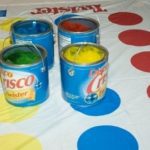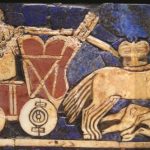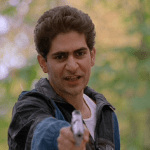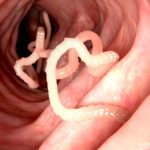 Animals
Animals  Animals
Animals  Weird Stuff
Weird Stuff 10 Weird Things People Used to Do at New Year’s
 Our World
Our World 10 Archaeological Discoveries of 2025 That Refined History
 Weird Stuff
Weird Stuff 10 Fascinating Facts You Might Not Know About Snow
 Miscellaneous
Miscellaneous Top 10 Things Crypto Was Supposed to Change & What Actually Did
 History
History 10 Huge Historical Events That Happened on Christmas Eve
 Music
Music 10 Surprising Origin Stories of Your Favorite Holiday Songs
 History
History 10 Less Than Jolly Events That Occurred on December 25
 Weird Stuff
Weird Stuff 10 Funny Ways That Researchers Overthink Christmas
 Politics
Politics 10 Political Scandals That Sent Crowds Into the Streets
 Animals
Animals 10 Species That Refused to Go Extinct
 Weird Stuff
Weird Stuff 10 Weird Things People Used to Do at New Year’s
 Our World
Our World 10 Archaeological Discoveries of 2025 That Refined History
Who's Behind Listverse?

Jamie Frater
Head Editor
Jamie founded Listverse due to an insatiable desire to share fascinating, obscure, and bizarre facts. He has been a guest speaker on numerous national radio and television stations and is a five time published author.
More About Us Weird Stuff
Weird Stuff 10 Fascinating Facts You Might Not Know About Snow
 Miscellaneous
Miscellaneous Top 10 Things Crypto Was Supposed to Change & What Actually Did
 History
History 10 Huge Historical Events That Happened on Christmas Eve
 Music
Music 10 Surprising Origin Stories of Your Favorite Holiday Songs
 History
History 10 Less Than Jolly Events That Occurred on December 25
 Weird Stuff
Weird Stuff 10 Funny Ways That Researchers Overthink Christmas
 Politics
Politics 10 Political Scandals That Sent Crowds Into the Streets
10 Surprising Facts about the Final Beatles Song “Now and Then”
The fans of a band that has not been together for a long time are usually excited to hear a previously unreleased song from the group. So it was big news when word came out that a new Beatles song would be released in November 2023, more than 50 years after the Fab Four went their separate ways, especially since John Lennon and George Harrison both passed away decades ago.
“Now and Then” started out as an unfinished song written and recorded by Lennon. The other three Beatles worked on it briefly in the 1990s, but the technology was not yet advanced enough to produce it the way they wanted. However, customized 21st-century software finally enabled Paul McCartney and Ringo Starr to complete the last song from this iconic band. Here are the 10 most surprising facts about what appears to be the final Beatles song, “Now and Then.”
Related: 10 Rock Songs That Shook The World
10 Yoko Ono Supplied the Recording
In its original form, “Now and Then” was among the unreleased demos of songs written and sung by John Lennon in the late 1970s, which Lennon’s widow, singer/songwriter/multimedia artist Yoko Ono, gifted to the remaining Beatles for their mid-1990s Anthology.
This kind of co-operation is somewhat surprising considering all the reports that have come out over the years about friction between Ono and the other three Beatles, largely due to her presence in the studio during Beatles recording sessions. While McCartney himself denies that Ono was responsible for breaking up the band, he did admit: “I don’t think any of us particularly liked it. It was an interference in the workplace.” He said that Lennon and Ono’s relationship “was bound to have an effect on the dynamics of the group.”
There were a total of four recordings given to McCartney. The first two songs created using this collection of demos, “Real Love” and “Free as a Bird,” were released on the anthology series, while “Grow Old with Me,” which had been released on the Lennon/Ono album “Milk and Honey” in 1984, was passed over.
The technical challenges involved in producing “Now and Then” resulted in the project being shelved for more than 25 years before finally being issued as a single in 2023 with a remixed version of the band’s first UK single, “Love Me Do.” Ono highly praised the completed version of “Now and Then.”[1]
9 Used AI for Technical Issues
While two of John Lennon’s songs from the old cassette demos made their way onto The Beatles Anthology in the 1990s, it took decades longer for “Now and Then” to be released because there were technical issues that could not be overcome at the time. However, technological advancements finally made it possible to do what was needed.
The piano on the original recording overshadowed Lennon’s vocals in places. As McCartney explained, “Every time we wanted a little bit more of John’s voice, this piano came through and clouded the picture.” AI was used to separate Lennon’s voice from the sound of the piano on the demo, allowing it to be mixed the way they wanted.
Some critics have questioned whether or not Lennon would have approved of this song being released. In a mini-documentary, Now and Then–The Beatles Last Song, McCartney expressed confidence in his belief that Lennon would be in favor of this production. So did Lennon’s own son, Sean, who said, “My dad would have loved that. He was never shy to use recording technology—I think it’s really beautiful.”[2]
8 George Harrison’s Opinion of the Demo
George Harrison was very critical of the demo when he first heard it, saying that he thought it was “f**king rubbish.” His reaction was reportedly due to the poor quality of the demo and not the song itself. Ringo Starr also had a negative reaction, later explaining that Lennon’s voice was “hidden,” which “brought to the fore to the three of us that he was gone.”
Since Harrison died long before Lennon’s vocals could be successfully extracted from the demo, he never heard the completed song, but his widow, Olivia, feels like he gave his approval from beyond. She believed this to be true as a result of something that happened when Paul McCartney called to talk to her about the song. She happened to be looking at a clock, recently relocated to her mantle piece, which George Harrison had bought many years ago, with scrabble letters attached to it that said: “Now and Then.” She took this as a sign that it was alright with him to release the song.[3]
7 Some Musicians Were in the Dark
It’s difficult to imagine what it would feel like to be a musician working on a historic recording like the final Beatles song, especially if you didn’t know what you were contributing to until after the fact. At one point, Paul McCartney decided the track would benefit from string accompaniment. So he brought in an orchestra.
The music for the string arrangement, composed by McCartney, Ben Foster, and Giles Martin, was displayed on stands for the musicians to read, but since the project was top secret, they were just told that it was something for McCartney and were unaware that they were actually accompanying a previously unreleased Beatles song.
“They were excited to be playing on this new piece of music, even though they didn’t quite know what it was,” said McCartney, who praised the musicians’ ability.[4]
6 It Took 45 Years to Finish
“Now and Then” was written by John Lennon and recorded as a demo in the late 1970s within just a few years of his being murdered at the age of 40 in 1980. It wasn’t until the mid-1990s that the remaining Beatles could begin work on the project. George Harrison laid down a guitar track in 1995, but his contribution would be posthumous since he died of cancer in 2001, over 20 years before the song’s ultimate release.
The reason it took so long to complete production on the track, once the demo was in Paul McCartney’s possession, is that the group had to wait for technology to catch up with what they wanted to do: extract Lennon’s vocals from the sound of the piano on the original tape.
Director Peter Jackson used cutting-edge audio de-mixing technology for 2021’s The Beatles: Get Back that allowed him to separate sounds and voices into different tracks. McCartney requested this technology for this song. However, McCartney has made it clear that Lennon’s voice was not manufactured. His genuine vocals are featured in the song.
After this, McCartney and Ringo Starr were finally able to finish the project, which was produced by McCartney alongside Giles Martin, the son of legendary Beatles producer George Martin. So it took 45 years, including the decades it was shelved, for “Now and Then” to come to fruition.[5]
5 Lennon’s Parting Words to McCartney
John Lennon’s last words to Paul McCartney when they met in person for the final time were reportedly: “Think about me every now and then, old friend.” According to a famous story, he said this following the well-documented evening the two spent together in 1976, during which they considered accepting an offer to reunite on an episode of Saturday Night Live.
Since the phrase that serves as the song’s title, “Now and Then,” is heard throughout the song, it is understandable that some have speculated the song was a message from Lennon to McCartney. In fact, Paul McCartney himself thinks this was the case.
The possibility that Lennon may have been writing to McCartney makes this tender and poignant song even more compelling. While McCartney admitted there were multiple discussions among the former bandmates about reuniting prior to Lennon’s death, they never came to a unanimous agreement. He doesn’t know if the four would have eventually reformed had Lennon lived.[6]
4 Recorded at Home
The original demo for “Now and Then,” featuring John Lennon’s vocals, which is part of the completed production, was not recorded in a studio but at home. It may not be unusual for modern artists to record demos and released tracks at home, but they normally use a room with sophisticated equipment that’s been set up for this purpose.
However, in this case, Lennon simply recorded himself singing the song on a boom box in his New York apartment at the Dakota. His son Sean, who was only five years old when John Lennon died, remembers his father frequently playing music around the house and recording demos on cassettes. On this rough track, the sound of a television can even be heard in the background.
In order to have all four members performing on the track, this tape of Lennon singing the song had to be used because, of course, he was no longer alive when the project went into production. It is ironic that such a simple recording is at the heart of something as historically and culturally relevant as the last Beatles song. Still, at the same time, it seems strangely appropriate.[7]
3 Deeply Emotional Reaction after AI Fix
Many fans have reacted very emotionally to this previously unreleased recording of John Lennon’s voice so long after his death, but Lennon’s clean vocal track also had a powerful impact on those in the studio after being extracted from the original demo. Ringo Starr described what it was like to hear this purified recording of his former bandmate singing “Now and Then,” saying, “It was the closest we’ll ever come to having [Lennon] back in the room, so it was very emotional for all of us. It was like John was there, you know. It’s far out.”
Paul McCartney had a similar response, explaining in a press release that the experience of hearing Lennon’s voice coming through “crystal clear” on the track was “quite emotional.”[8]
2 Features 1960’s Beatles Vocals
In addition to the John Lennon vocals that were lifted from his 1970s demo and the voices of bandmates recorded many years later, “Now and Then” also features vintage Beatles backing vocals from the original recordings of songs: “Here, There and Everywhere,” “Because,” and “Eleanor Rigby.”
As far as the music itself, Paul McCartney plays the piano and bass guitar on the song, as well as doing a slide guitar solo in the style of George Harrison. Ringo Starr plays the drums, and George Harrison’s electric and acoustic guitar performances, recorded for the song in the mid-1990s, are used as well. Interestingly, this practice of the band recording parts of a song individually started long before the death of John Lennon. Even when all four members were still together as a group, they would sometimes record their contributions separately to be pieced together later.[9]
1 Impact of The Beatles: Get Back Doc
While similar tools exist on various apps and elsewhere, a custom-made stem separation technology nicknamed MAL was used for “Now and Then,” which was reportedly developed by the team of engineers who worked on the popular 2021 documentary series The Beatles: Get Back from filmmaker Peter Jackson. The doc features extensive footage filmed during the making of the group’s 1969 Let It Be album.
When the audio from the archival footage was successfully remixed, allowing The Beatles’ voices to be separated from background noises and instruments, it was Paul McCartney who thought of revisiting the “Now and Then” project, using the new software to try and lift John Lennon’s vocals from the demo. The result was Lennon’s cleaned-up acapella vocal, which ended up being used in the completed production of the song. Considering how interested The Beatles were in new technology, it makes sense that the idea to apply MAL to “Now and Then” came from McCartney himself.
Peter Jackson, who is an enthusiastic Beatles fan and feels that the world today could use some cheering up from The Beatles, revealed one of the most exciting aspects of this story: that there may somehow be more additional releases of new Beatles music in the future. It would come as a surprise to many, considering all the attention “Now and Then” has gotten, being billed far and wide as the last Beatles song.
Jackson speculated that material from The Beatles: Get Back could be utilized for another song. According to Deadline, the filmmaker has said that he possesses archival studio footage of one or another of the bandmates rifting on a musical idea. Jackson explains: “We can take a performance from Get Back, separate John and George, and then have Paul and Ringo add a chorus or harmonies.”
One thing seems obvious. The type of technology that was customized for the documentary and subsequently used in the production of “Now and Then” could potentially have a significant impact on how music is created going forward.[10]








